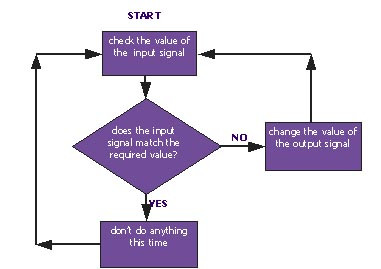Computer Control Software
This is the use of a computer to monitor and control an external process. Input sensors are used by the computer to monitor the various parts of a process that it is controlling. Before any process can be controlled by a computer a control program must be written by a human to tell the computer what to do.
Analogue and digital signals
- A sensor can send two types of signal to a computer – digital and analogue.
- Digital signals can only have two values: on (or true) and off (or false).
- Analogue signals can have any value.
- To process analogue signals the computer needs an analogue-to- digital converter.

Feedback
- Feedback control systems use the values of their output signals to affect the value of their input signals.
- This is useful when a certain set of conditions needs to be constantly maintained.
- Output signals make changes to the conditions outside which will affect its input signals.

Sensors
Many different types which can each measure some physical quantity outside the computer such as:
- Temperature;
- Pressure;
- Light;
- Water and moisture levels;
- Relative humidity;
- Movement and wind speed.
Sensors detect analogue data which is converted into digital data before it is sent to the computer
Actuators
- Many control systems need to control devices that can move such as a motor in a greenhouse to open or close a window.
- A device called an actuator is used to generate signals that can make devices move.
Microprocessors
These are used to control automatic machines by following pre-programmed sets of instructions called control programs.
Found around the home in for example:
- Video recorders;
- Camcorders;
- Hi-fi systems;
- Microwave ovens;
- Dishwashers;
- Burglar alarms
Robots
Used in hundreds of applications e.g.
- Assembling and spray-painting cars
- Maintaining overhead power cables
- Testing blood samples
They all have the same basic hardware components:
- sensors which are used to monitor changes in physical conditions such as speed and position;
- a microprocessor to process the information received from sensors;
- actuators to produce movement or turn external devices like switches on or off
Advantages of robots
- They can work in environments that are hazardous to humans, such as in outer space, underwater or in radioactive environments
- They can perform repetitive and boring tasks without needing to stop for a break
- The quality of their work is always the same because they never get bored or have an off-day
- They can work to a greater level of accuracy than humans
- They can work 24 hours a day, seven days a week, resulting in increased productivity
The main disadvantage of robots is that they are expensive to buy and install
